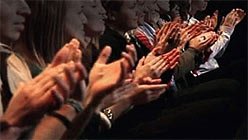Audience as Subject, Part I: Medium, the first of a two-part exhibition at Yerba Buena Center for the Arts, brings together a group of artists whose work complicates and calls out the participatory exchanges within spectatorship and the visual landscape. Including work by collaborative duo caraballo-farman, Stefan Constantinescu, Danica Dakic, Adrian Paci, Shizu Saldamando, Gabriel Acevedo Velarde, and Ulla von Brandenburg, the exhibition reveals the ways meaning is produced and exchanged not simply by what one looks at, but in how one looks and why.
Caraballo-farman’s video installation Veneration (Applause 3) (2009-2010) reveals the intertwined relationship between spectator and spectatorship from a panoramic vantage point. Upon entering the main exhibition gallery, split into separate screening rooms, the unmistakable sound of applause greets a visitor, penetrating the dim space. If one pulls back the curtain of Veneration, numerous television monitors are revealed. They face each other in an evenly spaced circle on the floor, the monitors looping hours of thunderous applause generated by live studio audiences. The artists have omitted the subjects of their applause, as well as the context in which they are viewing — no talk-show hosts, game contestants, or red-carpet divas are present. Isolated, the audiences are shown in a continuous state of approval, exhilaration, idolization, and anticipation before the impending staged climax of the unidentified shows.
Stepping within the circle of screens at their feet, a viewer is suddenly the subject of this extreme adoration — the overwhelming applause greets the gallery viewer who is merely looking at the studio audiences on-screen. At times, it feels as though the televised audiences are simply applauding each other, applauding. The installation does more than just position a viewer as the new focus of the applause. Rather, it exposes the reciprocal exchange present and necessary within the practice of looking. If the audience needs someone to watch, then in return, those being watched must have an audience. One cannot exist without the other.
In another screening room, Stefan Constantinescu’s Troleibuzul 92 (2009) questions the role of the passive and unintended viewer. In the video, a man gets on a crowded bus and then makes a phone call to someone a viewer may presume is a girlfriend, wife, or lover. His call is threatening, pierced with the thrusts of a suspicious partner’s speech. The man’s monotone voice and lack of expression are incongruous with the violence in his words — cursing, accusations, and continuous threats of harm, even murder. His demeanor seems ambivalent — does he have any stake in his own threats? The calmness at the center of his behavior sits uncomfortably in the pit of one’s stomach. The impression is one of normalcy — as though the man makes such threats often, only occasionally acting on them. The busload of strangers seems to be aware of him, but they are not ruffled or overtly perturbed by him or his behavior.

“Troleibuzul 92,” Stefan Constantinescu, 2009 (still); Courtesy of the Artist and Yerba Buena Center for the Arts, San Francisco.
Constantinescu’s uncomfortable video reveals the moments in everyday life when one is suddenly thrust into the position of spectator, regardless of desire or unwillingness to occupy that role. How does responsibility operate within these unwanted and unexpected moments of visuality and surveillance? Does one call the police on a stranger who repeatedly threatens to kill someone? What happens if the man really does kill someone — who is responsible? Troleibuzul 92 exposes the passive viewer and questions where responsibility rests in increasingly public viewing practices.


